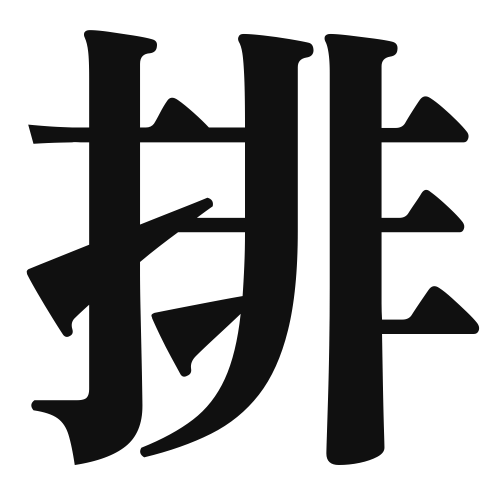1. Overview of Meaning
The kanji “排” (hai) generally means “to exclude,” “to reject,” or “to discharge.” It conveys the idea of pushing something away or removing it from a certain context.
2. Formation and Radical
Formation of the Kanji: The kanji “排” is a compound character (会意文字) that combines elements to convey its meaning. It consists of the radical “水” (water) on the left, which often relates to fluidity or movement, and “排” itself, which suggests the action of pushing or expelling.
Radical: The radical of “排” is “水” (water), indicating a connection to actions involving fluid or movement.
3. Examples of Usage
Common Words and Phrases: Some frequently used words that include “排” are:
- 排除 (はいじょ, haijo) – exclusion
- 排水 (はいすい, haisui) – drainage
- 排気 (はいき, haiki) – exhaust
Example Sentences in Daily Conversation:
- この問題を排除する必要があります。 (Kono mondai o haijo suru hitsuyou ga arimasu.) – We need to exclude this issue.
- 排水がうまくいかない。 (Haisui ga umaku ikanai.) – The drainage is not working well.
4. Synonyms and Antonyms
Similar Kanji: A kanji with a similar meaning is “除” (jo), which also means “to remove” or “to eliminate,” but it often implies a more careful or deliberate action compared to “排.”
Opposite Kanji: An antonym of “排” is “受” (ju), which means “to receive” or “to accept,” indicating the opposite action of welcoming or taking in.
5. Cultural and Historical Background
Connection to Japanese Culture: The concept of “排” is often seen in discussions about social dynamics, such as exclusion in group settings or the importance of acceptance in Japanese culture.
Proverbs and Idioms: One relevant proverb is “排除することは、受け入れることの反対である” (Haijo suru koto wa, ukeireru koto no hantai de aru), which translates to “Exclusion is the opposite of acceptance,” highlighting the balance between inclusion and exclusion in social contexts.
